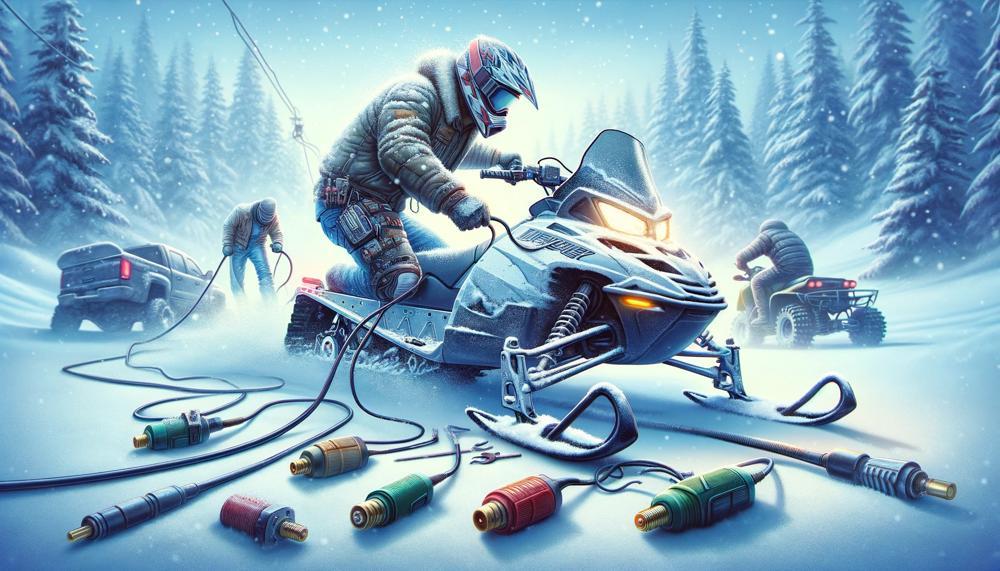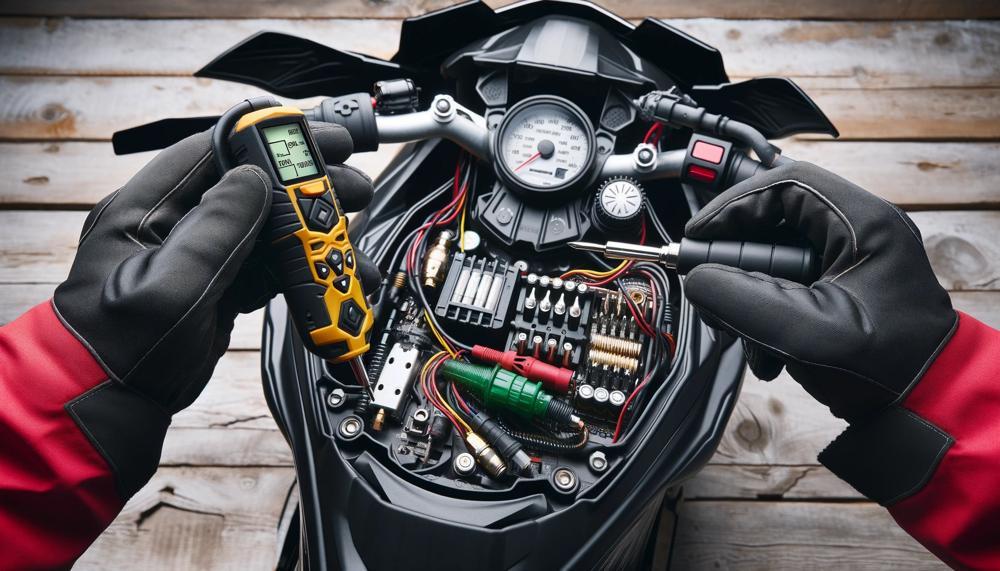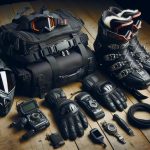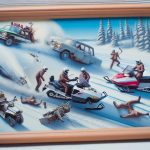Imagine this: you’re all geared up for an exhilarating day of snowmobiling, but when you hit the ignition, your beloved machine refuses to start. Your excitement quickly turns to annoyance as you keep trying with no success. But before you throw in the towel and head back inside, take a deep breath and let’s troubleshoot together.
In this blog post, we’ll be delving into the possible reasons why your snowmobile won’t start and how to fix them. From simple solutions to more complex issues, we’ve got you covered.
So, What To Do If Your Snowmobile Won’t Start?
A snowmobile needs spark, air, and fuel to run. Here are some things you can try if your snowmobile won’t start:
- Check the spark: Pull out the plugs and check for spark. If the plugs are dry, leave them out and put the choke on full while holding the throttle wide open. Crank over for 10 seconds or pull over 15-20 times.
- Check the gas: Smell the gas to see if it smells fresh or like old varnished gas. If your snowmobile has sat for a few years, you can try starting it with starting fluid.
- Check the fuel: Make sure the engine has the proper amounts of fuel. You can check the compression with a gauge, making sure all spark plugs are out when you do this. You can also check the engine oil and see if it smells like fuel. If it does, there is either too much fuel and its washing the cylinder walls causing the rings not to seal, or the rings/cylinders could be worn.
- Check the plugs: Make sure the plugs are clean and new.
Don’t let a stubborn snowmobile put a damper on your day of winter fun. By following these steps, you’ll be back out on the trails in no time. So let’s get started.
Weak or Dead Battery
Contents
There are multiple ways to determine whether your snowmobile’s battery is weak or dead. Some common signs include damaged terminals, leaks, discoloration, and cracks on the battery case. A distinct smell of melting or burning may also indicate a short circuit caused by loose or broken terminals.
One method to assess the battery’s charge and condition is by taking a voltage reading. If the reading shows 0 volts, it means that the battery has been completely discharged, possibly due to a short circuit. Furthermore, if the voltage does not increase above 10.5 volts after charging, it may have a dead cell.
Sulfation is another prevalent issue that can impede the battery from fully recharging, especially if it has been sitting unused for an extended period. To test the battery’s strength, you can use a digital voltmeter for load testing at home or at a repair shop. A healthy range for a 30-second reading is between 9.5-10.5 volts, and any drop in voltage during this time may indicate an underlying problem that requires professional assistance.
If you are unsure about your snowmobile’s battery status, it is best to seek help from Northeast Battery for diagnostics and repairs.
In addition to checking the battery, it is essential to inspect other components such as spark plugs, electrical components, and compression in cylinders before riding your snowmobile.
Remember to follow safety precautions while riding and take preventive measures before starting your snowmobile for a smooth and enjoyable ride.
Old Gas
Old gasoline can have a major impact on the starting of a snowmobile, resulting in issues such as fouled spark plugs and clogged fuel lines. These problems can make it difficult or even impossible to start the engine.
To avoid this, it is crucial to drain old gas before storing your snowmobile and add a fuel stabilizer to maintain the gas’s freshness over long periods of time.
Effects of Old Gas on Starting:
Old gas can cause multiple issues that significantly affect the starting of a snowmobile. One of the primary problems is fouled spark plugs. When gas sits for an extended period of time, the lighter components evaporate, leaving behind thicker and more viscous fuel. This can lead to carbon build-up on the spark plugs, resulting in poor ignition and difficulty starting the engine.
Another issue caused by old gas is clogged fuel lines. As the gas sits, it can separate into ethanol and water, leading to blockages in the fuel lines. This can prevent enough fuel from reaching the engine, causing it to sputter or fail to start at all.
Prevention Measures:
To prevent these issues caused by old gas, it is crucial to properly store your snowmobile. Before storing it for an extended period of time, drain all of the old gas from the tank and add fresh fuel. It is also recommended to use a fuel stabilizer that will help keep the gas fresh for longer periods of time.
Furthermore, regular maintenance of your snowmobile is essential. Checking for any signs of old gas build-up can help prevent these issues. This includes checking the spark plugs for carbon build-up and cleaning or replacing them if necessary. It is also recommended to check and clean the fuel lines regularly to ensure proper fuel flow to the engine.
Damaged or Blocked Fuel Lines
It’s essential to keep in mind that damaged or blocked fuel lines can have a significant impact on the starting of a snowmobile, especially in harsh cold weather conditions.
This is because fuel lines play a vital role in delivering fuel from the gas tank to the engine, and any obstruction or damage can hinder this process from happening seamlessly.
Effects on Starting
When fuel lines become damaged or blocked, it can lead to a shortage of fuel reaching the engine, creating difficulties in starting the snowmobile.
This problem can be even more troublesome in cold weather, as frigid temperatures can thicken the fuel, making it more challenging for it to flow through damaged or obstructed fuel lines.
Possible Causes
There are various potential causes for damaged or blocked fuel lines in a snowmobile. One common reason is not properly winterizing the snowmobile, which can result in frozen fuel lines.
Other possible causes include air filters becoming clogged, contaminated fuel, flooded carburetors, and faulty spark plugs or ignition coils.
Solutions
In some cases, simple solutions such as thawing out the frozen fuel line, cleaning the air filter, draining contaminated fuel, and clearing the carburetor may solve the issue. However, if the problem persists, it’s best to seek assistance from a mechanic or dealer for further diagnosis and repairs.
It’s crucial to exercise caution when working on a snowmobile and seek professional help if unsure about how to fix an issue.
Clogged or Damaged Air Filter
A snowmobile’s performance can be greatly affected by a clogged or damaged air filter. Indicators of this issue include reduced power and acceleration, strange noises from the engine, increased fuel consumption, warning lights on the dashboard, rough idling or stalling, black or gray smoke from the exhaust, and a gasoline smell.
To avoid potential long-term engine damage, it is important to regularly replace the air filter every 12,000 miles or 12 months.
However, if any of these symptoms are noticed, it is recommended to address the issue sooner rather than later.
The cost for an air filter replacement can range from $10 to $30 for paper filters and $30 to $100 for reusable filters. While this may seem like a small expense, it can save you time and money in the long run by preventing further engine damage and improving fuel consumption.
It is crucial to note that standard air filters are not reusable and must be replaced when dirty or damaged. Therefore, regular maintenance is key to ensuring optimal performance of your snowmobile. If you are unsure about inspecting or replacing the air filter yourself, it is recommended to seek professional help from a qualified mechanic.
Driving with a clogged or damaged air filter not only affects the snowmobile’s performance but can also lead to increased fuel consumption. To avoid these issues, it is important to address any concerns with the air filter promptly.
Oil Troubles
When it comes to starting a snowmobile, there are several common issues that can arise with the oil. Such problems include insufficient lubrication and dirty or contaminated oil. To combat these issues, it is essential to regularly monitor and replace the oil according to the manufacturer’s recommendations and use high-quality, snowmobile-specific oil.
In case of an unexpected emergency, riders can troubleshoot by checking the level and quality of the oil and making any necessary adjustments before trying to start the snowmobile again.
One of the most common issues with snowmobile oil is a lack of lubrication, which can cause serious damage to the engine if not addressed. This can be caused by old or low-quality oil that has lost its ability to properly lubricate the engine’s moving parts. To prevent this issue, it is crucial to follow the manufacturer’s recommended oil change schedule and use only high-quality, snowmobile-specific oil.
Another common issue is dirty or contaminated oil, which can clog the engine and prevent it from starting. This can occur if the snowmobile is used in dusty or muddy conditions, or if the oil is not changed regularly. It is important to check the oil for any signs of contamination and change it if necessary to ensure smooth engine operation.
In case of an emergency where the snowmobile won’t start, it is essential to first check the oil level and quality. If the oil level is low, add more as needed. If the oil appears dirty or contaminated, it should be changed before attempting to start the snowmobile again.
By regularly maintaining and monitoring snowmobile oil, riders can prevent common issues and ensure smooth engine operation.
Dried up Carburetor
A dried up carburetor on a snowmobile can be triggered by various factors, including the buildup of dirt and debris, fuel contamination, and inadequate maintenance. These issues can lead to engine flooding, stalling, and difficulties in starting the snowmobile.

To remedy a dried up carburetor, it is crucial to meticulously clean it using proper tools and techniques. Here are some potential causes and solutions for a dried up carburetor on a snowmobile:
- Dirt and debris buildup: As snowmobiles are often used in dusty or muddy terrains, particles and debris can accumulate in the air intake system, causing clogs in the carburetor. To address this problem, the carburetor must be thoroughly cleaned with a carb cleaner solution, compressed air canister, and a wire brush to remove any buildup.
- Fuel contamination: Fuel can also be a source of dirt and debris that can lead to clogs in the carburetor. Using old or low-quality fuel can result in the buildup of varnish and gunk in the carburetor. To prevent this issue, it is recommended to use a fuel stabilizer and regularly clean the carburetor.
- Lack of maintenance: Regularly cleaning the carburetor is crucial to avoid issues like engine flooding or stalling. Neglecting to do so can result in a dried up carburetor. To fix this issue, one must follow safety precautions when handling flammable substances and accurately reassemble the carburetor components after cleaning.
- Professional assistance: In some cases, seeking help from a professional mechanic who specializes in carburetors may be necessary if experiencing difficulty starting the engine or noticing irregularities in performance.
Faulty Fuel Pump
The fuel pump is an essential component of a snowmobile’s engine, making it crucial to recognize the common indicators of a faulty fuel pump and how to address and resolve it.
Symptoms such as difficulty starting the engine, sluggish acceleration, sputtering or stalling, and unusual sounds coming from the fuel tank are all red flags of a potential fuel pump issue.
To effectively identify and resolve a faulty fuel pump, one can investigate for obstructed filters, examine the fuel lines, assess the fuel pump pressure, and replace the pump if necessary.
Consistent maintenance and proper upkeep of the fuel pump can significantly reduce the likelihood of encountering these problems.
Faulty ignition system
A malfunctioning ignition system can result in a snowmobile failing to start or run effectively. The ignition system is responsible for generating the spark that ignites the fuel in the engine, making any problems with this system detrimental to the snowmobile’s starting and running capabilities.
Here are some common indicators of a defective ignition system in a snowmobile:
- Difficulty Kickstarting – One of the most obvious indications of a flawed ignition system is difficulty starting the snowmobile. This could be due to various issues, including a weak spark or a total absence of spark.
- Engine Stalling – If the engine suddenly stalls while riding, it could be due to a problematic ignition system. This could be caused by a weak spark, leading to misfires that can eventually cause the engine to stall.
- Poor Performance – A defective ignition system can also result in subpar performance from the snowmobile. This could include sluggish acceleration, reduced power, and overall decreased performance.
- Backfiring – Another warning sign of a faulty ignition system is backfiring, which occurs when unburned fuel ignites in the exhaust system. This can happen if the spark timing is off or if there is a weak spark.
- No Spark – If there is no spark at all when trying to start the snowmobile, it is likely due to a faulty component of the ignition system, such as the CDI box.
To troubleshoot a faulty ignition system, it is crucial to test each component, including the battery, stator, spark plug, main fuse, ignition coil, rectifier/regulator, and ground. If any of these components are found to be defective, they should be replaced.
In some cases, it may be challenging to determine whether the issue lies with the CDI box or another component of the ignition system. In these situations, it is best to consult a professional mechanic with expertise in snowmobiles.
The Worst Case – Low or No compression
One of the worst-case scenarios for a snowmobile engine is low or no compression, which can be caused by several factors such as worn piston rings, damaged cylinder walls, and blown gaskets. These issues can cause difficulties in starting the engine, loss of power, and high fuel consumption.
To resolve this issue, it is crucial to address the root cause and make necessary repairs or replacements. Seeking assistance from a professional mechanic may be necessary for proper diagnosis and resolution of the issue.
There are several possible causes of low or no compression in a snowmobile engine, including:
- Worn Piston Rings: The piston rings play a vital role in creating a seal between the piston and cylinder walls, allowing for proper compression. However, these rings can wear out over time due to regular use and may need to be replaced. Signs of worn piston rings include excessive oil consumption and a decrease in engine performance. To fix this issue, a mechanic will need to replace the worn rings.
- Damaged Cylinder Walls: The cylinder walls are where the pistons move up and down during combustion. If these walls become damaged due to wear and tear or overheating, it can result in low or no compression. In this case, the cylinder walls may need to be repaired or replaced by a professional mechanic.
- Blown or Leaking Gasket: Another common cause of low compression is a blown or leaking gasket, which can occur due to overheating or poor maintenance. To resolve this issue, the gasket will need to be replaced by a mechanic.
Fix: Call a mechanic. Seriously.
Snowmobiling is one of the most exhilarating winter activities, but it can quickly turn into a nightmare if your beloved snowmobile breaks down in the middle of nowhere. While regular maintenance can prevent most issues, sometimes unexpected problems arise. And let’s be honest, not everyone is a snowmobile expert, which is why calling a mechanic is the best course of action when you encounter difficulty.
But when should you call for professional help? First and foremost, if you have already tried troubleshooting the issue but have been unsuccessful, it’s time to call in the experts. Don’t waste any more time trying to figure it out on your own. Not only will this save you time and frustration, but it will also prevent further damage to your snowmobile.
Another situation where calling a mechanic is necessary is if you own an older model snowmobile. While these machines are built to last, they do require more maintenance as they age. A mechanic will know exactly what needs to be done to keep your older snowmobile running smoothly.
Lastly, if there are any signs of a more serious issue such as engine failure or unusual noises, don’t wait any longer. Call a mechanic immediately. Delaying could result in even more damage and a bigger bill at the repair shop.
Conclusion
In conclusion, the frustration of a snowmobile that won’t start can quickly put a damper on your winter plans. But before giving up and retreating indoors, it’s crucial to troubleshoot the potential culprits behind the issue. From checking the battery and electrical connections to examining the fuel system and spark plugs, we’ve covered all the possible solutions in this blog post.
We’ve also delved into how old gas, damaged or blocked fuel lines, a clogged or damaged air filter, oil troubles, a dried-up carburetor, and a faulty fuel pump can all contribute to starting problems.
By regularly maintaining and properly storing your snowmobile and seeking professional assistance when needed, you can prevent these issues from arising.






